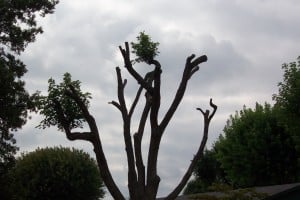Most fear is rooted in ignorance. Those are the words I found myself saying to my 9-year-old daughter on a recent field trip with my family to watch a local Beekeeper open one of his awakening hives. She was questioning how the apiary could have bees all over him and not be afraid “
because if just one of them flies over here I’m going to run,” she assured me. What is the difference between the calm beekeeper with thousands of buzzing bees on him and my nervous little girl ready to flee the scene? He has studied the bees so he knows the bees and understands them while she knows very few facts about them and only sees them as scary, icky, and out to sting her! The Beekeeper respects the bees; the 9-year-old fears them. I believe that same type of fear is one reason for the harmful pruning practices that plague our urban forests.
Every large tree is not an imminent failure threat but a drive through many of our city neighborhoods would lead you to believe that the only way to keep a tree safe if it’s near your house is to
“top”

Typical dieback caused by topping. Proper pruning is an art driven by science. There is no science that supports the destructive practice of topping a tree.
it. This practice is not only unsightly but it, in fact, makes the tree more prone to failure in the future. So why is this practice so common? Why would people harm their own trees with the many benefits they provide: lowering our electric bills, preventing erosion, lowering the
Heat Island Effect, and oh yeah, providing us with the very OXYGEN we breathe?
Most fear is rooted in ignorance. Most people don’t know the basic biology of a tree, how a tree addresses disease/pests, how a tree deals with decay, and therefore cannot recognize tree risk indicators. This problem is easily solved for those who are willing. A good starting point would be the
International Society of Arboriculture’s website. Also, many tree care companies that staff Certified Arborists will provide free quotes and identify potential tree risks during a walk-through of your property. Ask them what you should look for in your trees. If your neighborhood has a home owner’s association you may be able to have an arborist come to your neighborhood meeting and do a small educational presentation. As your understanding of trees increases your respect for them will grow and your fear of them shrink.
People fear trees rather than respect them because they don’t understand them and see their trees as more of a liability than a benefit. While it is true that every tree has the potential to fall or drop limbs and damage people and property, only a small percentage of them ever do. I’m not denying that a mature tree standing at 100+ feet tall, with a canopy spread of 50 feet, blowing in the wind of an oncoming storm can be a very menacing sight, in fact, I’ve stood at the base of trees that have left me speechless. However, with a little bit of study, a willingness to learn, and the help of qualified professionals tree risk can be managed and the likelihood of injury or property damage greatly reduced.
dan vernon

